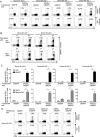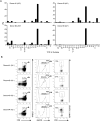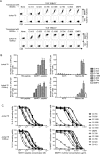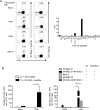Specific roles of each TCR hemichain in generating functional chain-centric TCR
- PMID: 25710913
- PMCID: PMC4369446
- DOI: 10.4049/jimmunol.1401717
Specific roles of each TCR hemichain in generating functional chain-centric TCR
Abstract
TCRα- and β-chains cooperatively recognize peptide-MHC complexes. It has been shown that a "chain-centric" TCR hemichain can, by itself, dictate MHC-restricted Ag specificity without requiring major contributions from the paired TCR counterchain. Little is known, however, regarding the relative contributions and roles of chain-centric and its counter, non-chain-centric, hemichains in determining T cell avidity. We comprehensively analyzed a thymically unselected T cell repertoire generated by transducing the α-chain-centric HLA-A*02:01(A2)/MART127-35 TCRα, clone SIG35α, into A2-matched and unmatched postthymic T cells. Regardless of their HLA-A2 positivity, a substantial subset of peripheral T cells transduced with SIG35α gained reactivity for A2/MART127-35. Although the generated A2/MART127-35-specific T cells used various TRBV genes, TRBV27 predominated with >10(2) highly diverse and unique clonotypic CDR3β sequences. T cells individually reconstituted with various A2/MART127-35 TRBV27 TCRβ genes along with SIG35α possessed a wide range (>2 log orders) of avidity. Approximately half possessed avidity higher than T cells expressing clone DMF5, a naturally occurring A2/MART127-35 TCR with one of the highest affinities. Importantly, similar findings were recapitulated with other self-Ags. Our results indicate that, although a chain-centric TCR hemichain determines Ag specificity, the paired counterchain can regulate avidity over a broad range (>2 log orders) without compromising Ag specificity. TCR chain centricity can be exploited to generate a thymically unselected Ag-specific T cell repertoire, which can be used to isolate high-avidity antitumor T cells and their uniquely encoded TCRs rarely found in the periphery because of tolerance.
Copyright © 2015 by The American Association of Immunologists, Inc.
Conflict of interest statement
S.T. is an employee of Takara Bio, Inc. This study was partly sponsored by Takara Bio, Inc. The University Health Network has filed a provisional patent application related to this study on which NH, MN, and TO are named as inventors.
Figures






Similar articles
-
CD4(+) and CD8(+) TCRβ repertoires possess different potentials to generate extraordinarily high-avidity T cells.Sci Rep. 2016 Mar 31;6:23821. doi: 10.1038/srep23821. Sci Rep. 2016. PMID: 27030642 Free PMC article.
-
Optimization of T-cell Reactivity by Exploiting TCR Chain Centricity for the Purpose of Safe and Effective Antitumor TCR Gene Therapy.Cancer Immunol Res. 2015 Sep;3(9):1070-81. doi: 10.1158/2326-6066.CIR-14-0222. Epub 2015 May 5. Cancer Immunol Res. 2015. PMID: 25943533 Free PMC article.
-
A single TCR alpha-chain with dominant peptide recognition in the allorestricted HER2/neu-specific T cell repertoire.J Immunol. 2010 Feb 1;184(3):1617-29. doi: 10.4049/jimmunol.0902155. Epub 2009 Dec 30. J Immunol. 2010. PMID: 20042572 Clinical Trial.
-
Molecular immunology lessons from therapeutic T-cell receptor gene transfer.Immunology. 2010 Feb;129(2):170-7. doi: 10.1111/j.1365-2567.2009.03227.x. Immunology. 2010. PMID: 20561357 Free PMC article. Review.
-
TCR affinity for p/MHC formed by tumor antigens that are self-proteins: impact on efficacy and toxicity.Curr Opin Immunol. 2015 Apr;33:16-22. doi: 10.1016/j.coi.2015.01.003. Epub 2015 Jan 22. Curr Opin Immunol. 2015. PMID: 25618219 Free PMC article. Review.
Cited by
-
A single-chain antibody generation system yielding CAR-T cells with superior antitumor function.Commun Biol. 2021 Mar 2;4(1):273. doi: 10.1038/s42003-021-01791-1. Commun Biol. 2021. PMID: 33654176 Free PMC article.
-
Affinity-matured HLA class II dimers for robust staining of antigen-specific CD4+ T cells.Nat Biotechnol. 2021 Aug;39(8):958-967. doi: 10.1038/s41587-021-00836-4. Epub 2021 Mar 1. Nat Biotechnol. 2021. PMID: 33649568
-
CD4(+) and CD8(+) TCRβ repertoires possess different potentials to generate extraordinarily high-avidity T cells.Sci Rep. 2016 Mar 31;6:23821. doi: 10.1038/srep23821. Sci Rep. 2016. PMID: 27030642 Free PMC article.
-
Mouse and Human CD1d-Self-Lipid Complexes Are Recognized Differently by Murine Invariant Natural Killer T Cell Receptors.PLoS One. 2016 May 23;11(5):e0156114. doi: 10.1371/journal.pone.0156114. eCollection 2016. PLoS One. 2016. PMID: 27213277 Free PMC article.
-
Establishment of potent TCR-T cells specific for cisplatin-resistance related tumor-associated antigen, CLSPN using codon-optimization.Hum Vaccin Immunother. 2024 Dec 31;20(1):2414542. doi: 10.1080/21645515.2024.2414542. Epub 2024 Nov 13. Hum Vaccin Immunother. 2024. PMID: 39539024 Free PMC article.
References
-
- Turner SJ, Doherty PC, McCluskey J, Rossjohn J. Structural determinants of T-cell receptor bias in immunity. Nature reviews Immunology. 2006;6:883–894. - PubMed
-
- Venturi V, Price DA, Douek DC, Davenport MP. The molecular basis for public T-cell responses? Nature reviews Immunology. 2008;8:231–238. - PubMed
-
- Miles JJ, Douek DC, Price DA. Bias in the alphabeta T-cell repertoire: implications for disease pathogenesis and vaccination. Immunology and cell biology. 2011;89:375–387. - PubMed
-
- Brennan RM, Petersen J, Neller MA, Miles JJ, Burrows JM, Smith C, McCluskey J, Khanna R, Rossjohn J, Burrows SR. The impact of a large and frequent deletion in the human TCR beta locus on antiviral immunity. Journal of immunology. 2012;188:2742–2748. - PubMed
Publication types
MeSH terms
Substances
Grants and funding
LinkOut - more resources
Full Text Sources
Other Literature Sources
Research Materials

